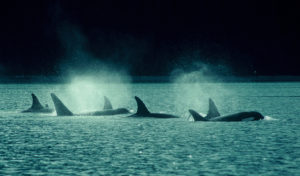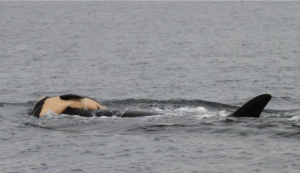
Over 26% of the Southern Resident Orcas in the Pacific Northwest Have died!
SEATTLE, WA — Three more of the critically endangered southern resident orcas have been declared dead by the Center for Whale Research.
The deaths bring the current population of southern resident orcas to just 73, down a staggering 26%!
These orcas are in urgent need of help as they are facing a double whammy – a food shortage and the food that they are finding to eat is so toxic that it is literally poisoning them to death.
The orcas who live here, by no choice of their own, have become urban whales and are the most contaminated whales in the world, containing over 200 times more toxins than the average human being on the planet !

Last summer, a female orca named Tahlequah, carried her dead calf for 17 days in grief. This made international headlines throughout the world but unfortunately little action followed this tragic event.
Our film, Orcas in Crisis”, which we made in 2001, helped get the orcas placed on both the US and Canada’s Endangered Species List. We will be returning to the Pacific Northwest later this year to update “Orcas in Crisis” and present it to the various agencies and individuals who can make the critical decisions to help save these magnificent creatures.
In order for the orcas to recover, their main food source, Chinook salmon need to recover, and the only way to ensure that is to remove the 4 lower dams on the Snake River which several industries are fighting. We are presenting solutions to these industries to get their support to remove these dams.
Here’s what you can do:
1. STOP THE ORCA POISONING
Scientific evidence has demonstrated that orca whales are threatened by the high levels of toxic contamination of their environment and food. It’s time to ensure a safe marine habitat for orcas and all marine life. Send an email to Governor Inslee by clicking on this link https://www.governor.wa.gov/contact/contact/send-gov-inslee-e-message or write to Governor Inslee, Office of the Governor, PO Box 40002, Olympia, WA 98504-0002. Demand that the “TOXIC SIX-SIXTY-TWO” (6 toxic sediment waste areas, 62 sites) be cleaned up immediately. Send a copy with a cover letter asking for action to your senators and congressmen.
2. ASSURE ORCAS’ FOOD SUPPLY
Chinook salmon are a mainstay in the southern resident orca diet. Adopt a salmon stream, river or even an entire watershed. There are organizations and grassroots efforts you can join for hands-on watershed restoration projects. Involve your family, friends, business accociates and other social groups to join with you.
Also support the groups calling for the removal of the lower 4 dams on the Snake River. Send an email to Governor Inslee by clicking on this link https://www.governor.wa.gov/contact/contact/send-gov-inslee-e-message or rrite to Governor Inslee, Office of the Governor, PO Box 40002, Olympia, WA 98504-0002. Demand that he take action to remove the 4 lower Snake River dams to help the Chinook salmon and Southern resident orcas to recover.
3. SAVING WATER SAVES ORCAS
The water we waste or save is essential to the salmon who in turn are essential to the survival of the southern resident Orcas. You can help by installing a water-saving device on every water source in your home now. Whenever you can, install fixtures such as showerheads that do better than the 2.5 gallons per minute (gpm) that serves as the current industry and government standard. Reduce your use of hot water, make it a priority in your conservation efforts, as it will have the greatest return (energy + water) for effort.
4. SAVING ELECTRICITY SAVES ORCAS
Buy one or two energy saving compact fluorescent bulbs every paycheck and replace the standard bulbs until your entire home is completely equipped. Electricity produced by hydropower uses the water salmon need to spawn. Without the salmon, the southern resident orca whales will become extinct. If you own a business, contact your utility today regarding the many programs that support, subsidize and help you plan your water and energy conservation. If you work at a business, encourage and practice conservation.
5. STOP TOXIC RUN-OFF
Most of the toxics we use on our lawns and in our homes run off into rivers and the marine environment where salmon and orcas feed. You can reduce and eliminate toxic substances in your home and on your lawns, including cleaning products, lawn chemicals and pesticides. Use non-toxic alternatives and ensure that any toxic chemicals you have are taken to your nearest toxic waste disposal site.
6. Please support The Whaleman Foundation.
We need your financial support now more than ever!
You must be logged in to post a comment.

[…] If your not a ‘fin’ of Seaworld ( because if you are the nice x on the right hand of your screen works) you’re going to want to hear about the long journey of Granny, if you haven’t already. The believed to be 105-year old orca is not a story you hear when killer whales are in captivity. As of around July 2017, 165 orcas have died in captivity in reports shown by us.whales.org. This does not cover the 30 that miscarried or stillborn calves. Only estimated around 80 whales of Granny’s kind ( Southern Resident) are left. At the same time, orcas like Granny feed off of a certain fish called Chinook Salmon. Unfortunately, the population of Chinook salmon is also an extreme plunge. “Orca survival depends on protecting Chinook salmon,” says David Suzuki. This concludes low reproducing rates. You can read more in regards to saving orca’s and how our pollution is entering the food chain HERE […]